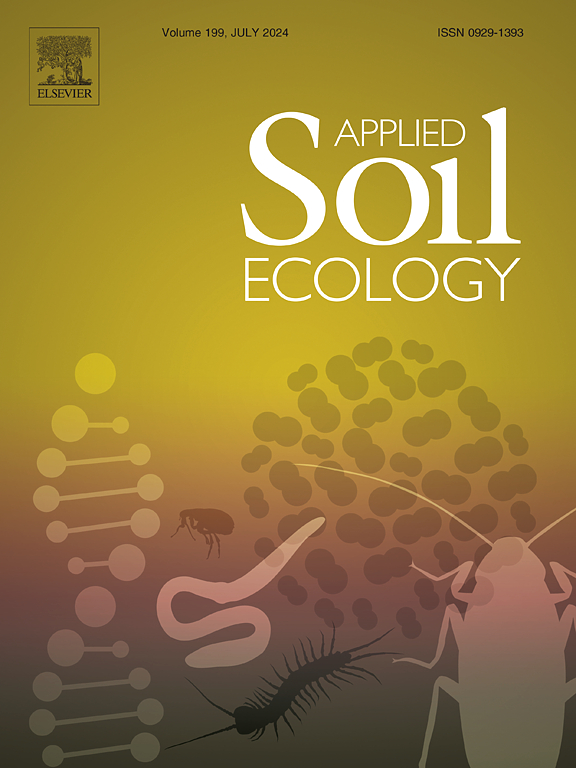真菌和细菌反硝化基因对亚热带森林土壤季节变化、氮沉降和降水减少的不同响应
IF 5
2区 农林科学
Q1 SOIL SCIENCE
引用次数: 0
摘要
中国的亚热带森林被广泛认为是世界上最大的一氧化二氮(N2O)天然来源之一,这主要是由于人为活动造成的高氮(N)沉积。气候变化使亚热带地区降水减少日益普遍,显著影响N2O排放。反硝化作用是亚热带森林土壤N2O排放的主要过程;然而,大多数先前的研究都集中在细菌反硝化上,往往忽视了真菌反硝化。本研究采用随机完全区组设计,每处理4个重复,在亚热带森林土壤中进行因子试验。我们研究了模拟N沉降、降水减少及其组合对编码亚硝酸盐还原酶的基因丰度的影响,包括细菌(nirK, nirS)和真菌(nirK)变体,重点研究了它们在夏季和冬季的季节性动态。氮沉降和降水还原处理效果明显。冬季氮沉降显著降低真菌和细菌的nirK丰度,夏季显著降低细菌的nirS丰度。冬季降水减少进一步抑制了细菌的nirK和nirS丰度,但对真菌的nirK没有影响。除处理效果外,季节变化也影响了基因丰度,真菌nirK水平在冬季较高,细菌nirK水平在夏季较高,而细菌nir保持季节性稳定。利用随机森林模型进行预测分析,发现速效磷(AP)是真菌nirK丰度的最强驱动因素。细菌nirK主要受土壤pH和AP的影响,而铵是细菌nirS的关键调节因子。这些结果强调了真菌和细菌反硝化菌对季节变化、氮沉积和降水减少的不同响应,强调了在未来气候情景下研究生物地球化学循环及其环境控制时需要考虑这两种微生物群。这些见解对于完善N2O通量的预测模型和设计亚热带森林生态系统的明智管理实践至关重要。本文章由计算机程序翻译,如有差异,请以英文原文为准。
Distinct responses of fungal and bacterial denitrification genes to seasonal changes, nitrogen deposition and precipitation reduction in subtropical forest soils
China's subtropical forests are widely recognized as one of the world's largest natural sources of nitrous oxide (N2O), primarily due to high nitrogen (N) deposition from anthropogenic activities. Climate change has made precipitation reduction increasingly common in subtropical regions, significantly influencing N2O emissions. Denitrification is the main process contributing to N2O emissions in subtropical forest soils; however, most previous studies have focused on bacterial denitrification, often overlooking fungal denitrification. In this study, a factorial experiment was conducted using a randomized complete block design with four replicates per treatment, in a subtropical forest soil. We examine the effects of simulated N deposition, precipitation reduction, and their combination on the abundance of genes encoding nitrite reductase enzymes, including bacterial (nirK, nirS) and fungal (nirK) variants, with a focus on their seasonal dynamics during summer and winter. N deposition and precipitation reduction treatments showed distinct effects. N deposition significantly reduced fungal and bacterial nirK abundance in winter and decreased bacterial nirS abundance in summer. Precipitation reduction further suppressed bacterial nirK and nirS abundance in winter but had no effect on fungal nirK. In addition to treatment effects, seasonal variation also shaped gene abundances, with higher fungal nirK levels in winter and higher bacterial nirK in summer, while bacterial nirS remained seasonally stable. Predictor analysis using random forest models identified available phosphorus (AP) as the strongest driver of fungal nirK abundance. In contrast, bacterial nirK was primarily influenced by soil pH and AP, while ammonium was the key regulator of bacterial nirS. These results highlight the distinct responses of fungal and bacterial denitrifiers to seasonal changes, nitrogen deposition, and precipitation reduction, emphasizing the need to consider both microbial groups when examining biogeochemical cycles and their environmental controls under future climate scenarios. These insights are crucial for refining predictive models of N2O fluxes and for designing informed management practices in subtropical forest ecosystems.
求助全文
通过发布文献求助,成功后即可免费获取论文全文。
去求助
来源期刊

Applied Soil Ecology
农林科学-土壤科学
CiteScore
9.70
自引率
4.20%
发文量
363
审稿时长
5.3 months
期刊介绍:
Applied Soil Ecology addresses the role of soil organisms and their interactions in relation to: sustainability and productivity, nutrient cycling and other soil processes, the maintenance of soil functions, the impact of human activities on soil ecosystems and bio(techno)logical control of soil-inhabiting pests, diseases and weeds.
 求助内容:
求助内容: 应助结果提醒方式:
应助结果提醒方式:


